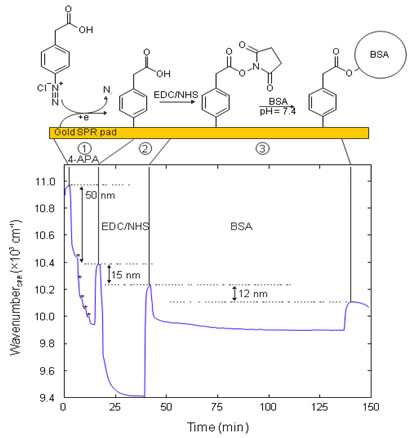Gap Mode
As two plasmonic structures approach within a few nanometers there is a huge enhancement of the plasmon intensity in the gap between the two structures as energy is transferred from one structure to the other. This energy transfer is a subject of interest in the energy community for "nano antennas" and other forms of harvesting, transferring, and focusing electromagnetic energy. Some in the analytical chemistry community or exploiting the enhancement phenomena to improve the signal of surface enhanced Raman spectroscopy (SERS). Many purveyors of SPR spectroscopy have incorporated nanoparticle enhancement as a method to improve sensitivity, yet these groups generally important nanoparticles solely as mass labels to increase the local refractive index.
We are interested in sensors that exploit the large change the plasmonic properties observed from minute changes in the distance between two properly tuned plasmonic structures.
Plasmonic substrates. Incorporating spaced nanoparticles within an ordered nano structure array can lead to large changes in the plasmonic properties as movement of the nanoparticles create conduits for the plasmons to more freely flow across the nanostructure. Relative movement of these nanoparticles can form or break these conduits.
Polymer transduction. Rigid Molecular Imprinted Polymers (MIPs) have long been used to impart chemical selectivity in, graphic stationary phases and surface responsive sensors. Flexible MIPs, that swell or contract with environmental stimuli, can be used as a transduction mechanism for SPR sensors. However the changes refractive index following expansion or contraction that results from a small concentration of analyte is often insufficient for real-world analytical applications. Incorporating plasmonic nanoparticles in these sensor coatings provides the mode for analytical signal enhancement. We are building polymer substrate for direct detection of biomolecules and pesticides in aqueous samples, and ammonia and other gases in the vapor phase.
Optical characterization
Visible and near IR transmission in total internal reflection spectroscopy are the bread-and-butter methods for characterizing nanoparticle arrays. We have constructed a novel variable angle stage that enables the traditional Kretschmann configuration analysis of plasmonic substrates in the near-IR and mid-IR from 0.8 nm to 12 nm. The AFM Raman can be equipped with the nanoparticle-terminated AFM tip to characterize the interaction between a single nanoparticle and plasmonic substrates.

For the molecular imprinted polymer sensor (scheme at top) we can monitor the growth of the polyallylamine hydrochloride (PAH) on the NHS-MHA functionalized gold surface by IR spectroscopy.

SPR sensorgram tracking the electrochemical deposition and functionalization of an organic linker on a sensing pad followed by binding of bovine serum albumin. Step 1 shows cycling through 5 voltages during the deposition. After each step, the pad was washed with a standard buffer solution to show the net SPR shift. Our novel mid-IR SPR sensor was employed so a decrease in wavenumbers is an increase in wavelength (red shift).
